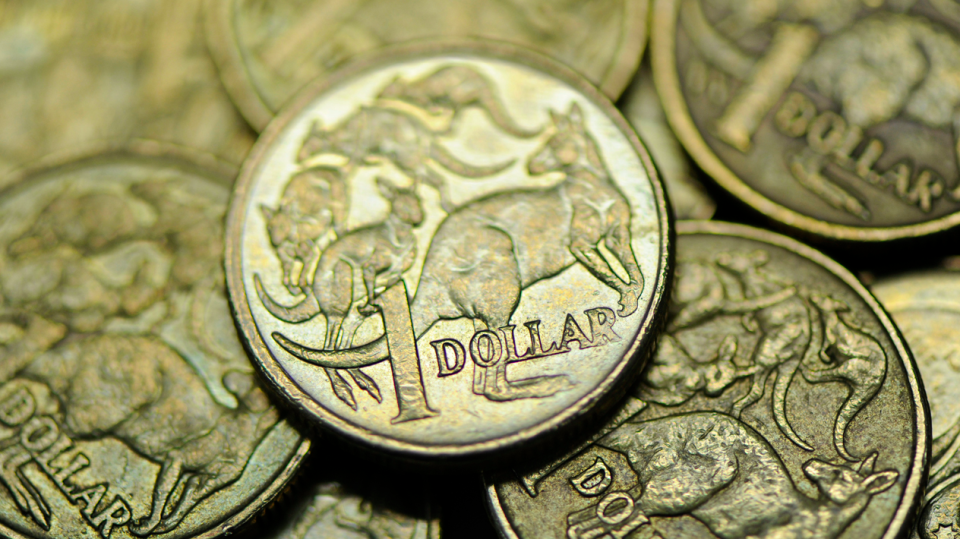The Australian dollar tumbles to its lowest level in over 2 years

The Australian dollar has fallen to its lowest level in over two years, both against the greenback and in trade-weighted terms.
The latest selloff coincided with strong US economic data and increased trade tensions between the United States and China.
Geopolitics will likely dictate the Aussie's movements this week, rather than economic data.
The Australian dollar has fallen to the lowest level in over two years, both against the greenback and in trade-weighted terms.
Also read: Apartments have slumped 15%: Meriton boss
Here's the scoreboard as at 8am in Sydney.
AUD/USD 0.7104 , -0.0002 , -0.03%
AUD/JPY 78.91 , 0.02 , 0.03%
AUD/CNH 4.8766 , -0.0066 , -0.14%
AUD/EUR 0.6150 , -0.0002 , -0.03%
AUD/GBP 0.5498 , 0.0003 , 0.05%
AUD/NZD 1.0869 , -0.0009 , -0.08%
AUD/CAD 0.9359 , 0.0004 , 0.04%
After losing ground earlier in the week on the back of weakness in emerging markets and out-of-cycle mortgage rate increases from three of Australia's four major banks, the Aussie's losses accelerated on Friday following the release of the US non-farm payrolls report for August which showed average hourly earnings rose by 2.9% over the past 12 months, the fastest increase in nine years.
As Richard Grace, Chief Currency Strategist and Head of International Economics at the Commonwealth Bank explains, that news helped not only to boost US bond yields but also the US dollar.
Also read: Mortgage rate hikes: How much will it cost you?
"[The] USD lifted strongly on the wages component," he said.
"The US 10-year treasury yield gained 6 basis points to 2.94%, and the US two-year yield increased 7 basis points to 2.71%."
Grace said the remaining details of the payrolls report were also supportive of higher US yields and dollar with the increase in non-farm payrolls stronger than expected while the unemployment rate held steady at 3.9%.
Along with firmer US data, the Aussie was further undermined by a lift in geopolitical tensions during the session.
"President Donald Trump threatened to sharply escalate the US trade war with China, saying his administration could move 'very soon' to impose tariffs on $US200 billion in imports from Beijing, with levies on a further $US267 billion in products 'ready to go on short notice'," said Ray Attrill, Head of FX Strategy at the National Australia Bank.
"This added fresh safe haven support to a US dollar rally, forcing the AUD/USD below 71 cents in the process."
As seen in the hourly chart below, the strong payrolls report lift in geopolitical tensions saw the AUD/USD break below previous support found at .7150.
And left the AUD/USD at the lowest level since February 2016.
The Aussie also fell to the lowest level since May 2016 in trade weighted terms.
Attrill at the NAB says whether the selloff in the Aussie will continue in the days ahead will largely be determined by news flow on trade negotiations, rather than economic data.
"Tariff news will likely remain front and centre of market psyche," he says.
In particular, most near-term interest will be on when and if the US imposes additional tariffs on $US200 billion worth of Chinese imports entering the country, something that could be introduced at any point from now on given the period of public consultation is now over.
Given that uncertainty, it's likely that traders will likely overlook most economic data released on Monday.
There's nothing scheduled in Australia but China will release consumer and producer price inflation data for August at 11.30am AEST. Japan will also release revised Q2 GDP figures at 9.50am AEST.
On the central bank front, Michele Bullock, Assistant Governor of the RBA, will deliver a speech on "the evolution of household sector risks" from 1.05pm AEST.
Later in the session, other data highlights include UK trade, GDP and industrial production, Eurozone investor sentiment as well as US consumer credit.

 Yahoo Finance
Yahoo Finance 


